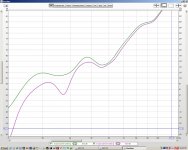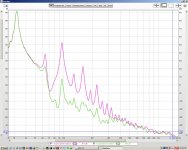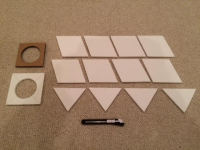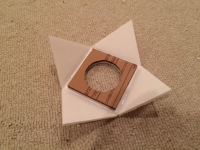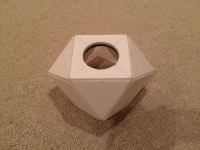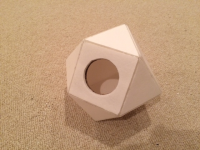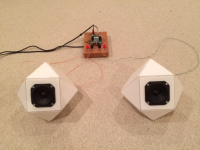For a strong joint in wood, you really want to press the two surfaces together tightly, rather than just holding them close. There shouldn't be a lot of glue in there between them. At least that's my experience from a furniture making perspective.
Driver is a Dayton RS100-4. It's quite good but notice that the freq is only plotted to 16.4khz. Also I used a little more smoothing this time (1/12 oct) because I saw that that's what you were using and I figured that's what all the cool kids were doing. The bump at ~16k is where things get a little ugly, but for my personal hi-fi listening, dsp makes short work of it.
The speaker was located just over 41" from the nearest surface (floor/wall/ceiling) which was the farthest away I could get it. That's why my original waterfalls don't extend into the lowest couple of octaves.
Mic was located about 3" from the driver and as I rotated the enclosure around I kept it centered in the same spot allowing the pyramid tops to get a little closer to the mic than the driver was...
Mic was located about 3" from the driver and as I rotated the enclosure around I kept it centered in the same spot allowing the pyramid tops to get a little closer to the mic than the driver was...
It might be interesting to compare the measurements of your foamcore rhomboid to a plain old cube of the same volume with the same driver.
... this design that has lain mostly neglected and ridiculed for 34 years.
I believe that if anything is being ridiculed here, it is not the design of these speakers, which may be perfectly wonderful; it is rather the 'explanations' of its merits, which frankly strike me as pseudo-metaphysical blather. There is a long history of this sort of obfuscating narrative in the audio world; and for someone who is passionately curious about the scientific reality of sound reproduction, it is just tiresome. Sorry but there it is.
Driver is a Dayton RS100-4. It's quite good but notice that the freq is only plotted to 16.4khz. Also I used a little more smoothing this time (1/12 oct) because I saw that that's what you were using and I figured that's what all the cool kids were doing. The bump at ~16k is where things get a little ugly, but for my personal hi-fi listening, dsp makes short work of it.
Ok it's because you are only 3in away which is why it is smooth. 1/12oct smoothing is good, make your plots go from 40dB to 100dB so that the features are not so flattened. Also you should go back at least to 0.5m away - this gives room needed for response from driver as a whole to integrate.
I understand, Slothrop. (Nice Pinchon handle, by the way). I'm going to stop explaining and let the data speak for themselves. It is always possible someone will publish a technical disquisition that will be more scientifically palatable. I have been working on something less metaphysical involving exterior calculus, but I will be just as happy if someone more specialized in audio engineering than me comes up with an acceptable explanation first.
Ok it's because you are only 3in away which is why it is smooth. 1/12oct smoothing is good, make your plots go from 40dB to 100dB so that the features are not so flattened. Also you should go back at least to 0.5m away - this gives room needed for response from driver as a whole to integrate.
Thanks for that. I have noticed the response gets smoother at close range. Right now I'm working on an 18" measurement (greater than 2x biggest dimension of the enclosure) to see how much of the hypercubes extra "efficiency" makes it into the room.
I ran a measurement at 18" for the sealed and hypercube enclosed driver to see how much of an effect the wide band resonance of the hypercube panels contribute to "increased efficiency" farther out in the room. At this distance, the efficiency of the hypercubes only seems to better the sealed box below about 120hz. I have to admit, I was hoping to see a little boost from the bass range up to about 3khz but that doesn't seem to be the case (above 120hz or so the panel resonance just seems to be helping to decrease directivity while adding some low level ambience).
However, at around 55 hz the output of the hypercube starts pulling away from the sealed box. From here down to 30hz, the output of the hypercube is more like a 2 to 7 db increase. Below 30hz the hypercube seems to be putting out 4 to 10db (or more) more than the sealed box. I ran the sweeps a couple of times each to make sure I was getting consistent results.
I originally provided a harmonic distortion comparison measurement for the sealed vs. hypercube speaker at 64 hz. I have now decided to make a similar measurement a 32 hz. It seems that (with the 32hz sine wave) the first overtone from the hypercube is 8db softer than the sealed box while the second and third overtones are something like 22db softer. This (along with the improved decay) would certainly help to explain the incredible improvement in bass quality I have observed with the hypercubes relative to the sealed boxes. Now, if I could only get outside to get some full-range waterfall plots....
However, at around 55 hz the output of the hypercube starts pulling away from the sealed box. From here down to 30hz, the output of the hypercube is more like a 2 to 7 db increase. Below 30hz the hypercube seems to be putting out 4 to 10db (or more) more than the sealed box. I ran the sweeps a couple of times each to make sure I was getting consistent results.
I originally provided a harmonic distortion comparison measurement for the sealed vs. hypercube speaker at 64 hz. I have now decided to make a similar measurement a 32 hz. It seems that (with the 32hz sine wave) the first overtone from the hypercube is 8db softer than the sealed box while the second and third overtones are something like 22db softer. This (along with the improved decay) would certainly help to explain the incredible improvement in bass quality I have observed with the hypercubes relative to the sealed boxes. Now, if I could only get outside to get some full-range waterfall plots....
Attachments
180 deg Polar data
I set up the Hypercube on the stand without anything blocking the direct radiator facing horizontal and took some polar data at 1 meter and 2.83v. The TC9FD is rated at 85dB at 1m and 2.83v - which is what I measure above the baffle step at 1kHz. So I don't see a 3dB gain overall. However, there is a pretty uniform sound field up to about 3kHz 360 deg around the Hypercube. This is probably the combination of re-radiated emission from the speaker walls.
Polar data up to 180 deg (360 would be the same as it is symmetric):
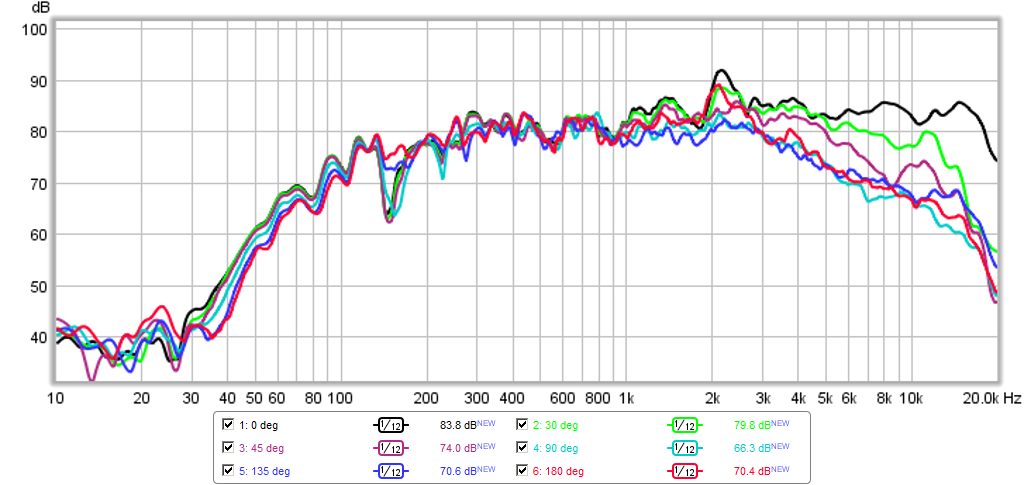
Here is the frequency response and minimum phase at 0 deg - the deep dip at 150Hz is floor bounce because it goes away when there is no direct radiation from the driver face:
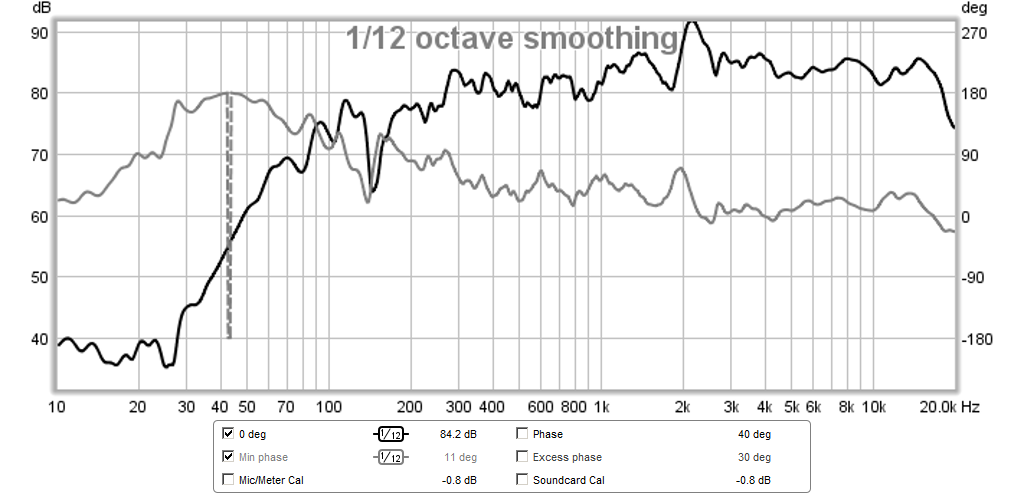
Here is the frequency response and minimum phase at 135 deg:
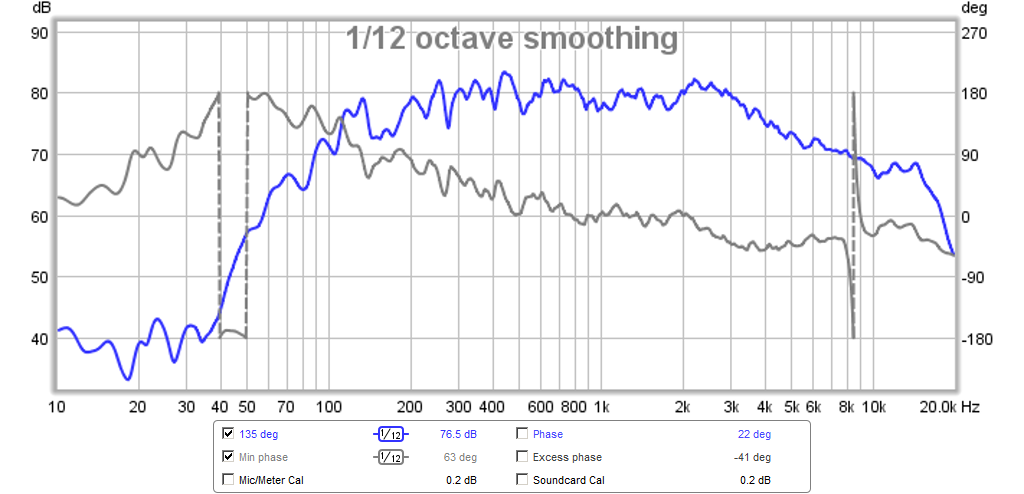
Here is the frequency response and minimum phase at 180 deg:
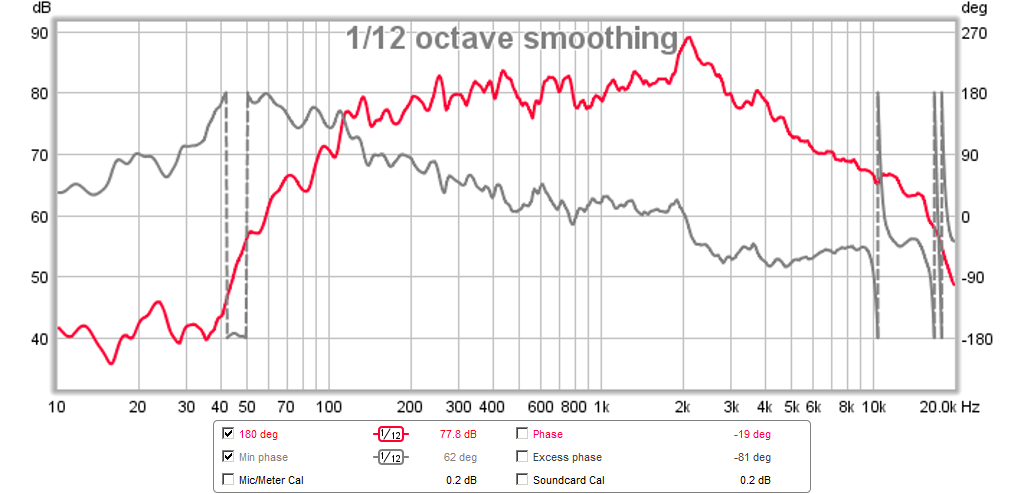
Here is the impulse response at 0 deg - pretty clean - this is an excellent impulse response indicating that percussion will sound sharp and distinct, and that most sounds will not have sibilance (and indeed listening to female vocals, there is no sibilance from the speaker):
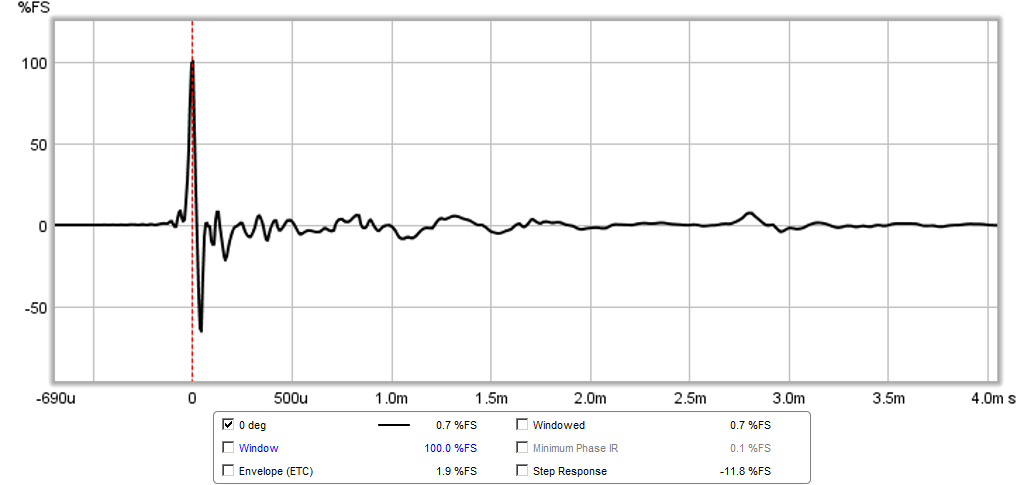
Here is the impulse response at 135 deg - still clean:
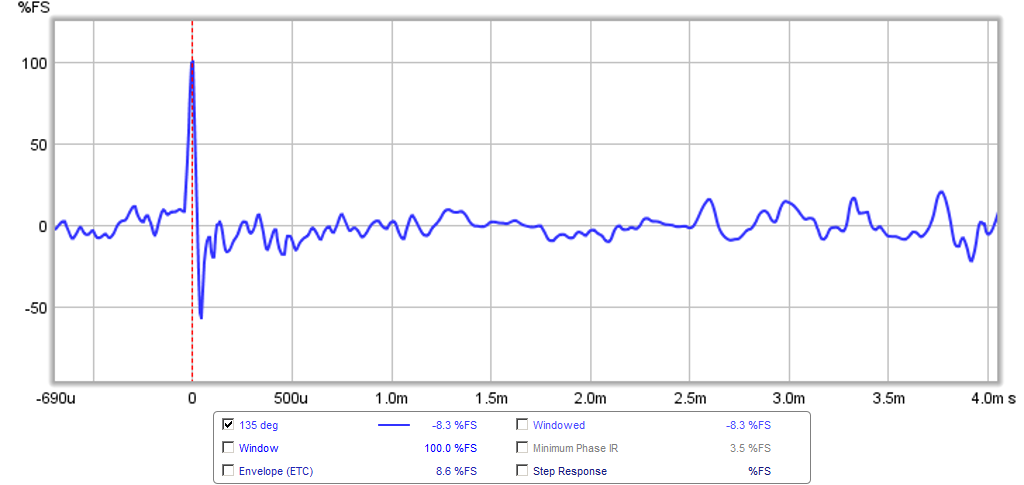
Here is the impulse response at 180 deg - very different from the other ones, and I believe the ringing is cause be the resonance drum head mode of the four rear panels like Mudjester's simulation shows. This ringing frequency corresponds to the huge 2.2kHz peak visible at 180 deg response:
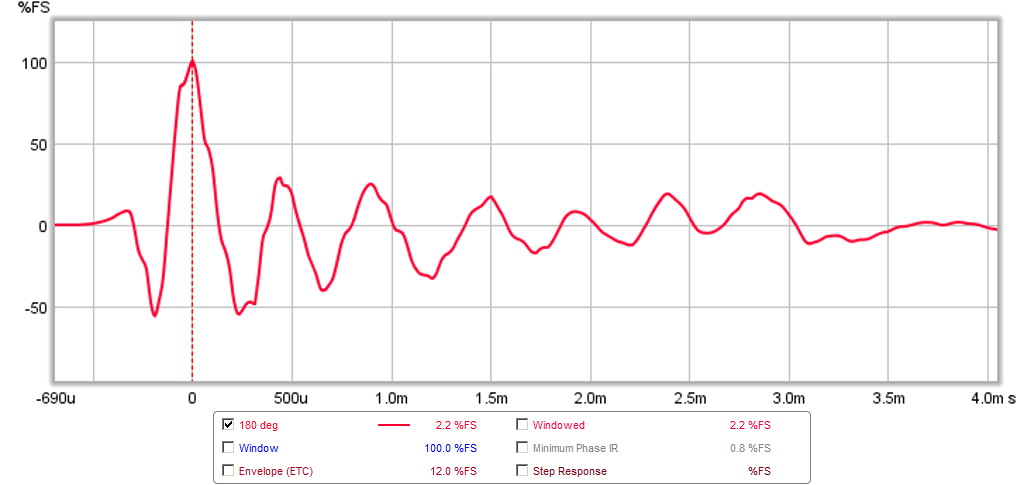
I set up the Hypercube on the stand without anything blocking the direct radiator facing horizontal and took some polar data at 1 meter and 2.83v. The TC9FD is rated at 85dB at 1m and 2.83v - which is what I measure above the baffle step at 1kHz. So I don't see a 3dB gain overall. However, there is a pretty uniform sound field up to about 3kHz 360 deg around the Hypercube. This is probably the combination of re-radiated emission from the speaker walls.
Polar data up to 180 deg (360 would be the same as it is symmetric):

Here is the frequency response and minimum phase at 0 deg - the deep dip at 150Hz is floor bounce because it goes away when there is no direct radiation from the driver face:

Here is the frequency response and minimum phase at 135 deg:

Here is the frequency response and minimum phase at 180 deg:

Here is the impulse response at 0 deg - pretty clean - this is an excellent impulse response indicating that percussion will sound sharp and distinct, and that most sounds will not have sibilance (and indeed listening to female vocals, there is no sibilance from the speaker):

Here is the impulse response at 135 deg - still clean:

Here is the impulse response at 180 deg - very different from the other ones, and I believe the ringing is cause be the resonance drum head mode of the four rear panels like Mudjester's simulation shows. This ringing frequency corresponds to the huge 2.2kHz peak visible at 180 deg response:

Attachments
-
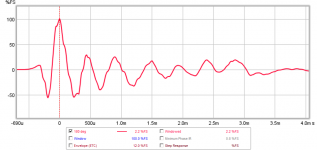 hypercube-with-stuffing-180-deg-ir.png53.8 KB · Views: 551
hypercube-with-stuffing-180-deg-ir.png53.8 KB · Views: 551 -
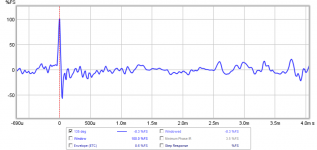 hypercube-with-stuffing-135-deg-ir.png52 KB · Views: 538
hypercube-with-stuffing-135-deg-ir.png52 KB · Views: 538 -
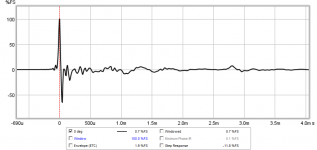 hypercube-with-stuffing-0-deg-ir.png43 KB · Views: 1,630
hypercube-with-stuffing-0-deg-ir.png43 KB · Views: 1,630 -
 hypercube-with-stuffing-180-deg-min-phase.png103.8 KB · Views: 546
hypercube-with-stuffing-180-deg-min-phase.png103.8 KB · Views: 546 -
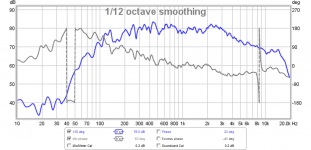 hypercube-with-stuffing-135-deg-min-phase.png96.8 KB · Views: 562
hypercube-with-stuffing-135-deg-min-phase.png96.8 KB · Views: 562 -
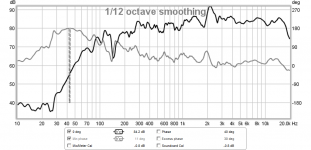 hypercube-with-stuffing-0-deg-min-phase.png89.1 KB · Views: 566
hypercube-with-stuffing-0-deg-min-phase.png89.1 KB · Views: 566 -
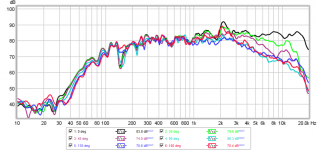 Hypercube-polar-180.png138.5 KB · Views: 1,418
Hypercube-polar-180.png138.5 KB · Views: 1,418
Last edited:
Foam Core Hypercube in Stereo
I had some time to throw the second one together and documented the build process in detail below. Sounds really nice in stereo, I may have to take this to the office.
Pieces all cut out:
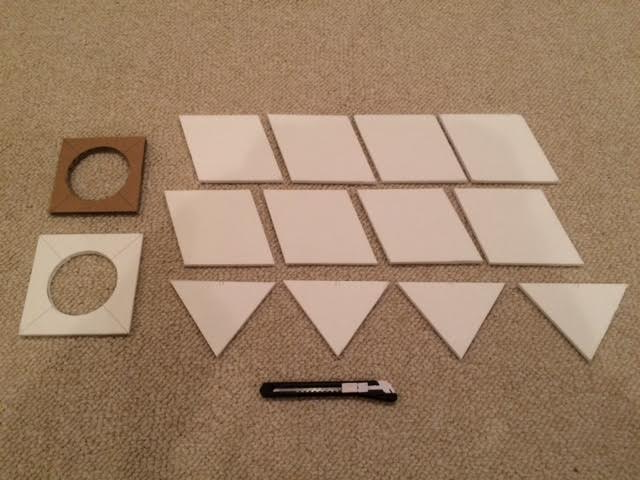
Glue the triangles to the square like a flower petal:
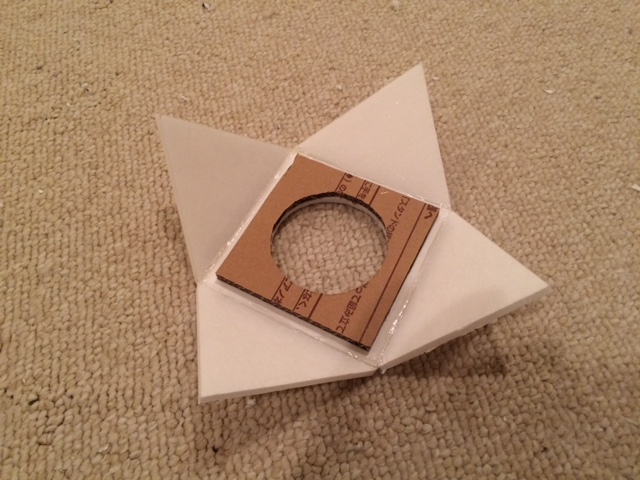
Glue the rhomboids to the triangles:
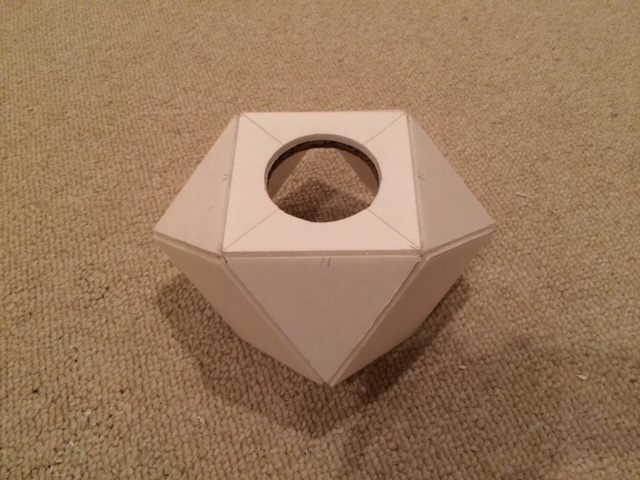
Glue the remaining rear 4 rhomboids to form the 'tailcone' - only one left tht needs to be capped off:
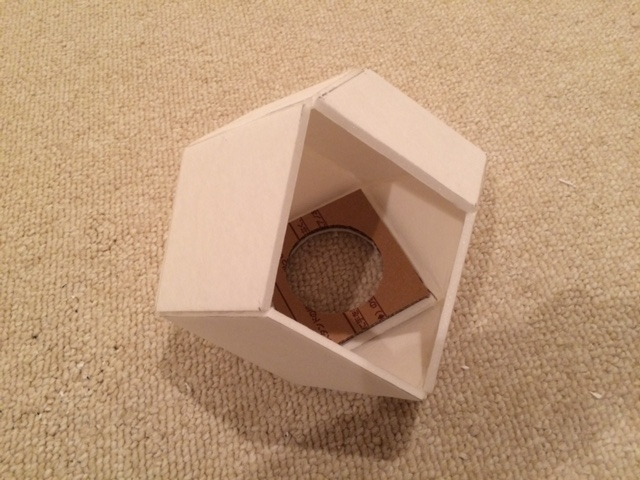
Done:
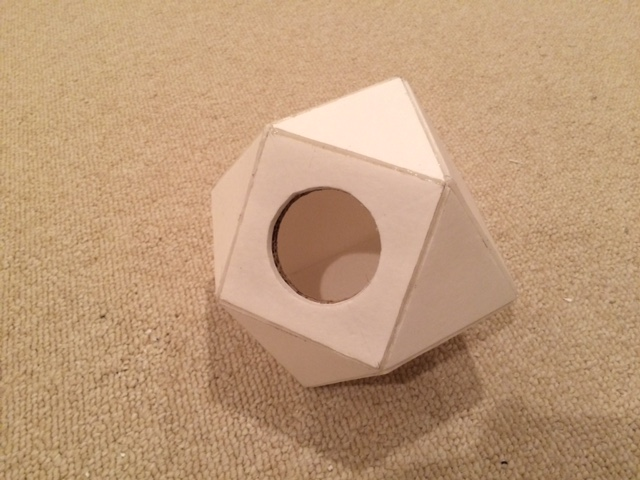
In stereo with TPA3116D2 amp:
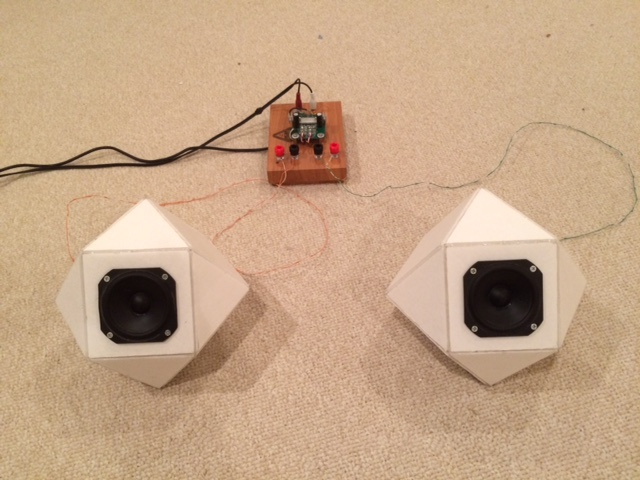
I had some time to throw the second one together and documented the build process in detail below. Sounds really nice in stereo, I may have to take this to the office.
Pieces all cut out:

Glue the triangles to the square like a flower petal:

Glue the rhomboids to the triangles:

Glue the remaining rear 4 rhomboids to form the 'tailcone' - only one left tht needs to be capped off:

Done:

In stereo with TPA3116D2 amp:

Attachments
Here is the first version of the software to calculate either (a) the piece sizes, starting from the internal volume you want or (b) the internal volume, starting from the outer square side length. Now anyone who wants to can design this cabinet to fit the Vas for whatever driver they want to use.
Calculate.html
Calculate.html
Hi X. Now this is starting to get interesting! I know you did some raw measurements for the Vifa at some point in an OB or naked. It would be interesting to see those overlayed with the tesseract speaker to see how much it improves things.
Another thing. How come you didn't use the fold method for this cab? EI cut angled slots to the second layer of cardboard and then fold the speaker after glue has been applied. It would give a neater look and would probably also be stronger.
Not all joints could be done like of course that but they could still have an angled cut.
Another thing. How come you didn't use the fold method for this cab? EI cut angled slots to the second layer of cardboard and then fold the speaker after glue has been applied. It would give a neater look and would probably also be stronger.
Not all joints could be done like of course that but they could still have an angled cut.
Questions xrk971
Once again really great work xrk971, thanks the efforts and sharing.
1. The measurement in post 190 is very interesting and great, do you ever had measured a more ordinary squarer box at those exstreme 90º and 180º or have a guess how such a more ordinary squarer box perform at a plot at those angels (Can it be revealed by putting a cardboard or foamcore rectangle box around the Hypercube and measure that).
2. Your foam core hypercube think looks great in measurements but must say if my eyes are right and your measurement at post 113 showing both the Hypercube and your Nautaloss II are done under exactly same measurement conditions that Nautaloss II plot is way more smooth and nice on axis, but question is if the conditions were the same and how off axis would compare.
Once again really great work xrk971, thanks the efforts and sharing.
1. The measurement in post 190 is very interesting and great, do you ever had measured a more ordinary squarer box at those exstreme 90º and 180º or have a guess how such a more ordinary squarer box perform at a plot at those angels (Can it be revealed by putting a cardboard or foamcore rectangle box around the Hypercube and measure that).
2. Your foam core hypercube think looks great in measurements but must say if my eyes are right and your measurement at post 113 showing both the Hypercube and your Nautaloss II are done under exactly same measurement conditions that Nautaloss II plot is way more smooth and nice on axis, but question is if the conditions were the same and how off axis would compare.
Hi X. Now this is starting to get interesting! I know you did some raw measurements for the Vifa at some point in an OB or naked. It would be interesting to see those overlayed with the tesseract speaker to see how much it improves things.
Another thing. How come you didn't use the fold method for this cab? EI cut angled slots to the second layer of cardboard and then fold the speaker after glue has been applied. It would give a neater look and would probably also be stronger.
Not all joints could be done like of course that but they could still have an angled cut.
I have OB measurements and also bare driver baffleless near range maasurments. I'll what I can dig up.
I thought about the fold method but cutting that requires cutting the whole things as a complex sheet as shown in the drawings posted earlier. Much easier to cut a long strip of correct width and then slice it off at diagonal cuts to right length. Also, the folding method will require leaving extra material at the folds for it to smoothly bend as there is a finitr thickness. It just seemed easier to make this way.
Once again really great work xrk971, thanks the efforts and sharing.
1. The measurement in post 190 is very interesting and great, do you ever had measured a more ordinary squarer box at those exstreme 90º and 180º or have a guess how such a more ordinary squarer box perform at a plot at those angels (Can it be revealed by putting a cardboard or foamcore rectangle box around the Hypercube and measure that).
2. Your foam core hypercube think looks great in measurements but must say if my eyes are right and your measurement at post 113 showing both the Hypercube and your Nautaloss II are done under exactly same measurement conditions that Nautaloss II plot is way more smooth and nice on axis, but question is if the conditions were the same and how off axis would compare.
I measured the Nautaloss II at about the same location in the room, same height given stands are the same. Nautaloss does not have resonances like Hypercube. I tested by humming notes on a scale and you can definitely feel and hear where that is. The polar of the Nautaloss at 90deg is also similar in falloff at 90deg - extends to 3kHz. That appears to be inherent to either the TC9FD or the room I measure in which may have redlections contributing? I don't have an anechoic chamber but try to orient the speaker and mix at 45 deg angles from walls and stay at least 2m away from walls. Floor and ceiling are another matter though.
Here is Nautaloss I polars:
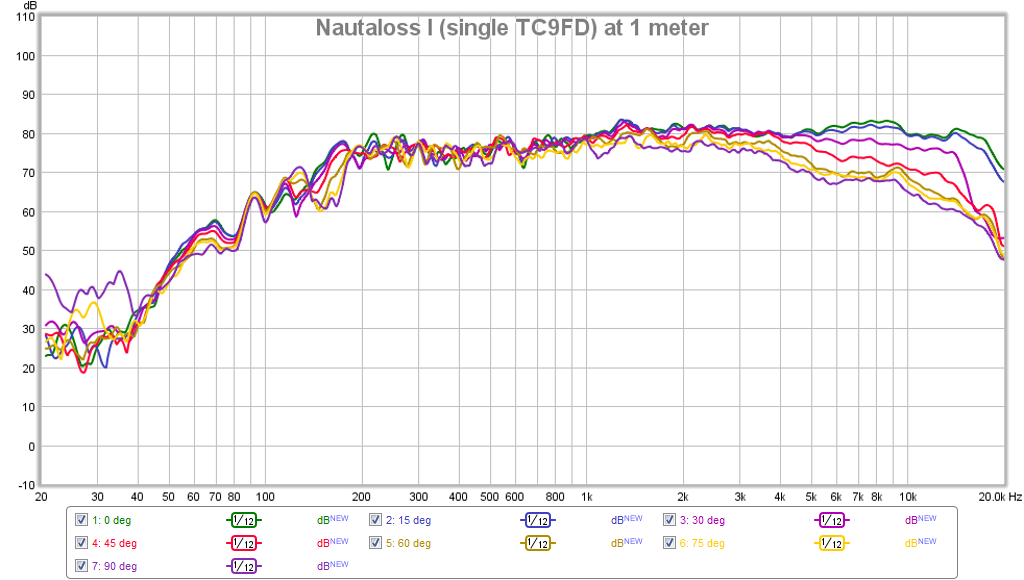
For comparison from post 190:

It is going to be tough to beat a progressively damped and tapered sealed spiral TL optical "Woods' Horn" for absorbing back reflections. As I recall, the open baffle response was the same but had less baffle step loss due to wider baffle of OB.
Last edited:
I measured the Nautaloss II at about the same location in the room, same height given stands are the same. Nautaloss does not have resonances like Hypercube. I tested by humming notes on a scale and you can definitely feel and hear where that is. The polar of the Nautaloss at 90deg is also similar in falloff at 90deg - extends to 3kHz. That appears to be inherent to either the TC9FD or the room I measure in which may have redlections contributing? I don't have an anechoic chamber but try to orient the speaker and mix at 45 deg angles from walls and stay at least 2m away from walls. Floor and ceiling are another matter though.
.....Removed two pictures - see them at post 197.....
It is going to be tough to beat a progressively damped and tapered sealed spiral TL optical "Woods' Horn" for absorbing back reflections. As I recall, the open baffle response was the same but had less baffle step loss due to wider baffle of OB.
Looks Nautaloss is great out to 90º not beaten by Hypercube when they both share foam core as box material.
Hypercube is very cool that 135º and 180º sits nearly as the 90º plot, though a quick guess is you never had measured Nautaloss these extremes.
Thanks post.
Here is the first version of the software to calculate either (a) the piece sizes, starting from the internal volume you want or (b) the internal volume, starting from the outer square side length. Now anyone who wants to can design this cabinet to fit the Vas for whatever driver they want to use.
Calculate.html
Thanks for that Tasserax, I still can't figure out why method of volume calculation is higher than your formula. Seems like they should be equal. Haven't had a chance to check with rice or beans.
One thing that anyone who has worked with geodesic domes or buckyballs will appreciate how stiff this structure is. Given sufficiently stiff or damped panels, this shape could make a very good sealed sub woofer enclosure without resorting to extensive internal bracing - which can be a pain. A Hypercube with a 22in edge on the square would make a great sub for an 18in driver. That would be 11/6 x 22in^3= 11.3 cu ft. A higher Qts driver would be perfect.
- Status
- Not open for further replies.
- Home
- Loudspeakers
- Full Range
- Hypercube Loudspeakers
